Input interpretation

bromoform
Chemical names and formulas

formula | CHBr_3 name | bromoform alternate names | bromoforme | methane, tribromo- | methenyl tribromide | tribromomethane mass fractions | Br (bromine) 94.8% | C (carbon) 4.75% | H (hydrogen) 0.399%
Lewis structure
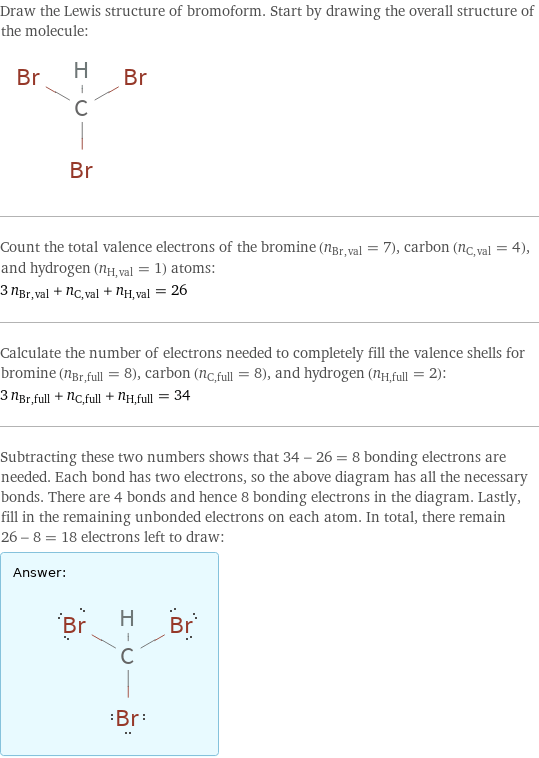
Draw the Lewis structure of bromoform. Start by drawing the overall structure of the molecule: Count the total valence electrons of the bromine (n_Br, val = 7), carbon (n_C, val = 4), and hydrogen (n_H, val = 1) atoms: 3 n_Br, val + n_C, val + n_H, val = 26 Calculate the number of electrons needed to completely fill the valence shells for bromine (n_Br, full = 8), carbon (n_C, full = 8), and hydrogen (n_H, full = 2): 3 n_Br, full + n_C, full + n_H, full = 34 Subtracting these two numbers shows that 34 - 26 = 8 bonding electrons are needed. Each bond has two electrons, so the above diagram has all the necessary bonds. There are 4 bonds and hence 8 bonding electrons in the diagram. Lastly, fill in the remaining unbonded electrons on each atom. In total, there remain 26 - 8 = 18 electrons left to draw: Answer: | |
3D structure

3D structure
Basic properties
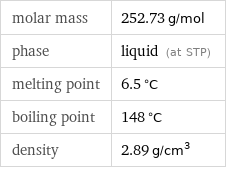
molar mass | 252.73 g/mol phase | liquid (at STP) melting point | 6.5 °C boiling point | 148 °C density | 2.89 g/cm^3
Units

Hydrophobicity and permeability properties

predicted LogP hydrophobicity | 2.5 predicted LogS | -2.13
Basic drug properties

approval status | experimental | small molecule drug categories | carcinogen | teratogen
Liquid properties (at STP)
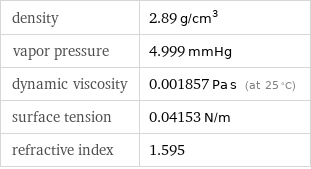
density | 2.89 g/cm^3 vapor pressure | 4.999 mmHg dynamic viscosity | 0.001857 Pa s (at 25 °C) surface tension | 0.04153 N/m refractive index | 1.595
Units

Thermodynamic properties
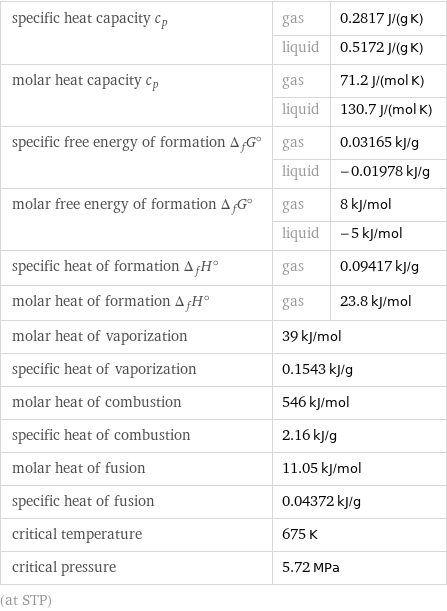
specific heat capacity c_p | gas | 0.2817 J/(g K) | liquid | 0.5172 J/(g K) molar heat capacity c_p | gas | 71.2 J/(mol K) | liquid | 130.7 J/(mol K) specific free energy of formation Δ_fG° | gas | 0.03165 kJ/g | liquid | -0.01978 kJ/g molar free energy of formation Δ_fG° | gas | 8 kJ/mol | liquid | -5 kJ/mol specific heat of formation Δ_fH° | gas | 0.09417 kJ/g molar heat of formation Δ_fH° | gas | 23.8 kJ/mol molar heat of vaporization | 39 kJ/mol | specific heat of vaporization | 0.1543 kJ/g | molar heat of combustion | 546 kJ/mol | specific heat of combustion | 2.16 kJ/g | molar heat of fusion | 11.05 kJ/mol | specific heat of fusion | 0.04372 kJ/g | critical temperature | 675 K | critical pressure | 5.72 MPa | (at STP)
Chemical identifiers
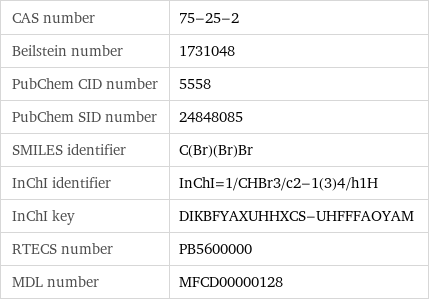
CAS number | 75-25-2 Beilstein number | 1731048 PubChem CID number | 5558 PubChem SID number | 24848085 SMILES identifier | C(Br)(Br)Br InChI identifier | InChI=1/CHBr3/c2-1(3)4/h1H InChI key | DIKBFYAXUHHXCS-UHFFFAOYAM RTECS number | PB5600000 MDL number | MFCD00000128
NFPA label

NFPA label
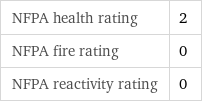
NFPA health rating | 2 NFPA fire rating | 0 NFPA reactivity rating | 0
Safety properties

flash point | 83 °C upper explosive limit | 35.3% (concentration in air)

DOT hazard class | 6.1 DOT numbers | 2515
Toxicity properties

lethal dosage | 1147 mg/kg (oral dose for rats) threshold limit value | 0.5 ppmv

probable lethal dose for man | 600 mL (milliliters) long-term exposure limit | 5 mg/m^3 (over 8 hours) RTECS classes | tumorigen | drug | mutagen | human data